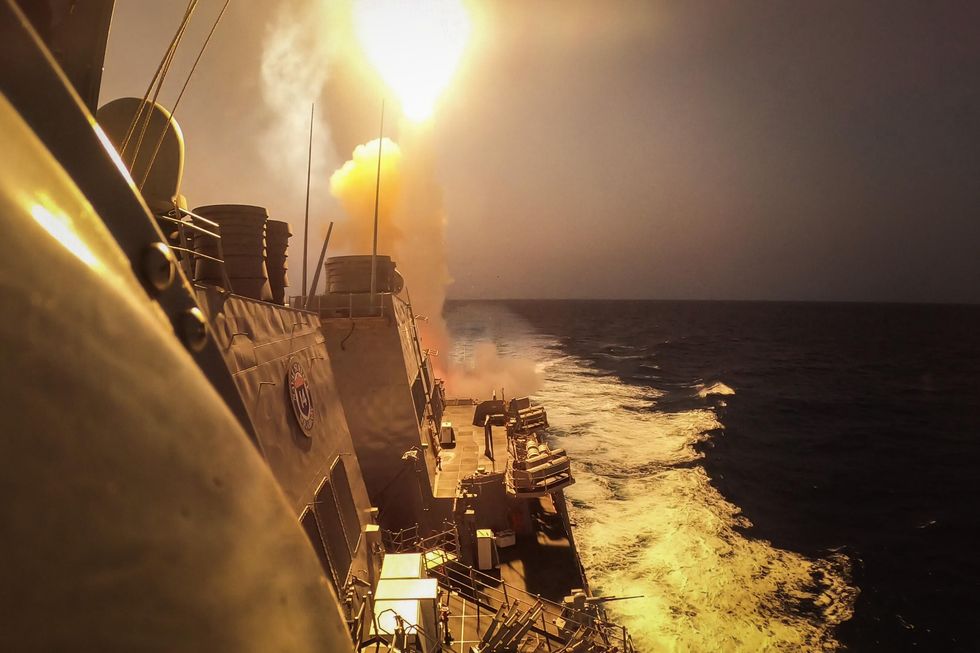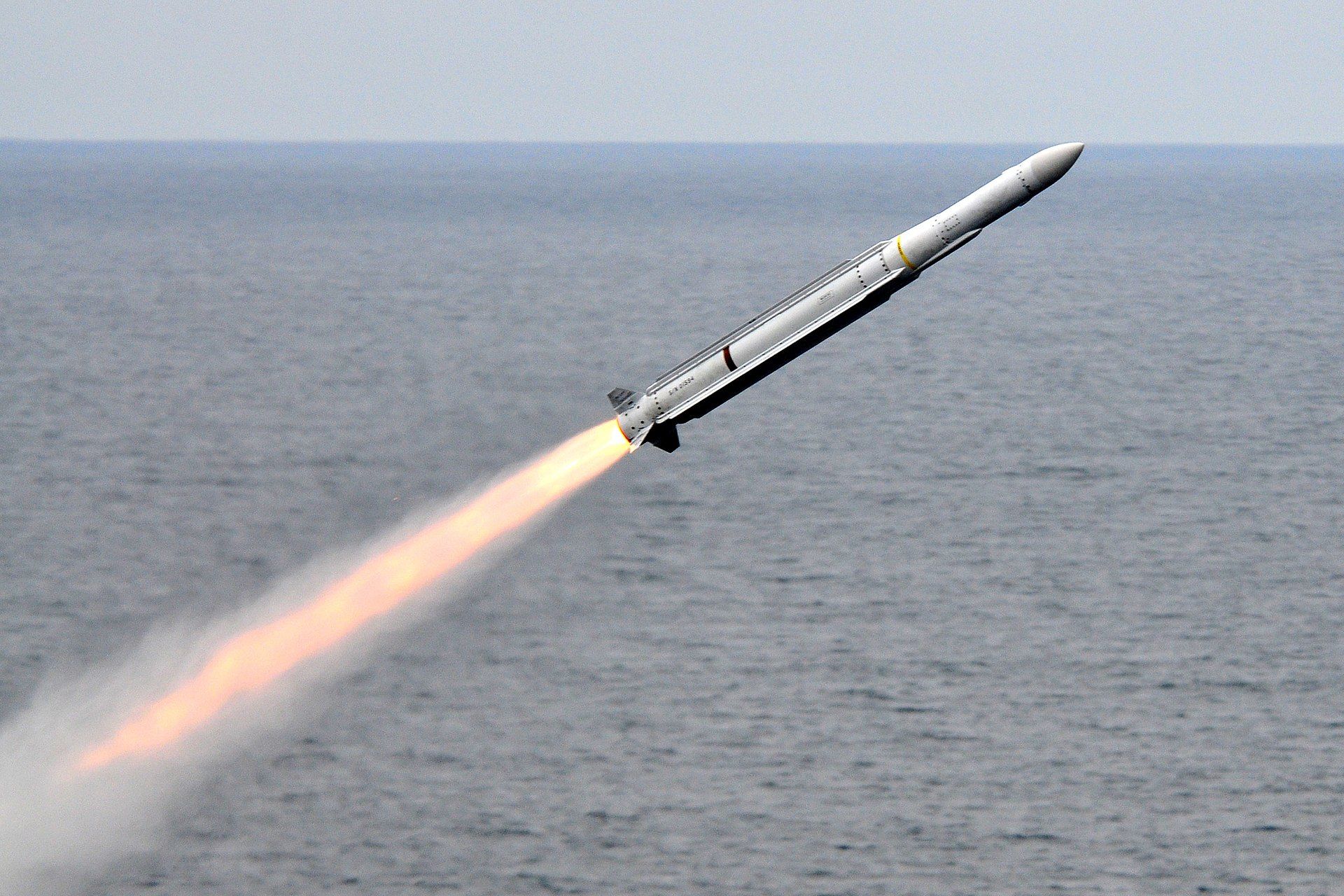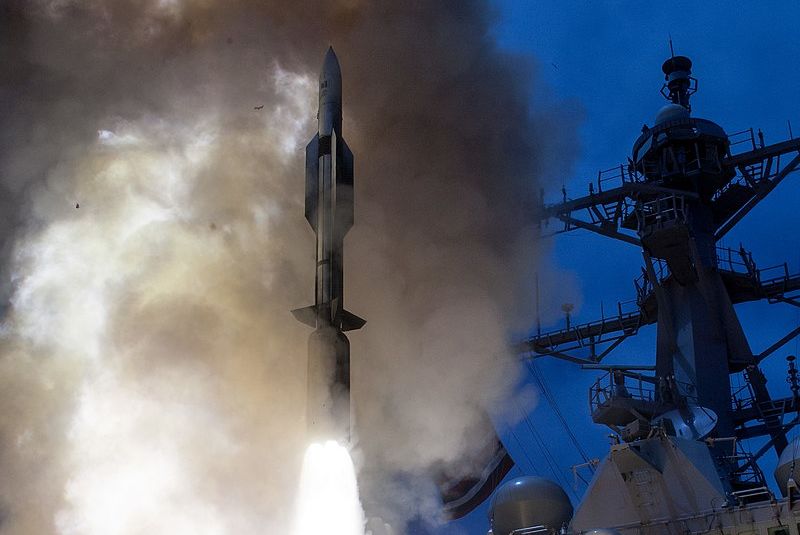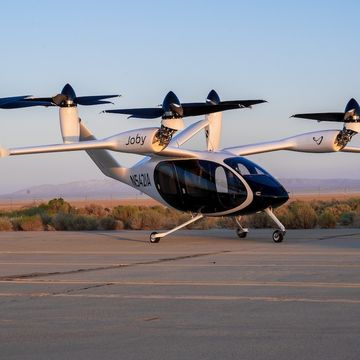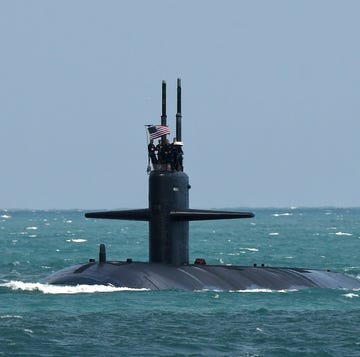On March 27, 2024, a U.S. warship in the Red Sea detected four radar tracks headed directly its way from Yemen. It fit the tell-tale pattern of drone attacks that Houthi rebels had been launching for months. Navy crews have fought off many such attacks since December and responded in the usual way: interceptor missiles roared into the sky from the ship’s deck, downing the attackers one by one at a safe distance. As usual, there was no damage to the ship and thankfully no casualties. But supplies of missiles are limited (and expensive) and the Houthis keep launching drones day after day—sometimes as many as 14 in one wave.
The attack highlights the asymmetric warfare threatening U.S. military dominance. While America leads the way in high-end, “exquisite” military hardware, powers like Iran and China are churning out large numbers of low-cost attack drones to overwhelm those weapons. America’s opponents know that missiles are effective, but they simply aren’t sustainable in the long run.
Paul Scharre, Ph.D., executive vice president and director of studies at the Center for a New American Security (CNAS), a Washington, D.C.-based defense think tank, has long warned that current weapons quickly become unaffordable against massed drones.
“Taking out a thousand-dollar drone with a million-dollar missile is not a cost-effective solution,” Scharre tells Popular Mechanics.
Such drones force warships to expend munitions, which could leave them open to attacks from larger anti-ship missiles. But not shooting down the drones is not an option.
“The goal of our potential opponents is to send over large numbers of cheap drones to deplete our kinetic arsenals,” Andrew Lowery, CEO of the Los Angeles, California-based high-tech weapon maker, Epirus, tells Popular Mechanics.
That’s why his company developed an alternate approach: a nearly unstoppable microwave weapon.
// Microwave Weaponry //
Epirus’ Leonidas Counter-Uncrewed Aerial System produces a powerful beam of microwaves, which generates currents inside electronic devices, causing them to overload. At best, electronics suffer temporary faults; at worst, components completely burn out. Either way, the microwave weapon effectively zaps drones out of the sky.
Unlike radio jammers, which confuse drone guidance or interfere with communications, the microwave weapon destroys them. Epirus first demonstrated Leonidas in 2020 and introduced the current third-generation model in 2022.
Rather than a traditional dish antenna, Leonidas’ emitter is a flat plate some ten feet across. This is because it’s based on an array of solid-state gallium nitride units, which resemble LEDs but produce radio waves rather than light. These emitters are more compact than the magnetrons used in traditional radar, and the technology is starting to take over in radar systems and 5G communications. A computer controller adjusts the output from each chip in the array to shape and steer the beam with high precision.
In 2021 tests, Leonidas brought down 66 out of 66 drone targets. In some tests, the system was challenged by multiple drones at once—and knocked them all out in one sweep.
Epirus has already delivered four Leonidas systems to the U.S. Army for evaluation. They could be ideal for tackling the waves of drones U.S. forces are now facing.
“The promise of directed energy for counter-drone applications is that, in principle, it could have a deeper magazine with a lower cost-per-shot than missiles,” Scharre explains. “We need cost-effective defenses to counter cheap drones.”
// Expensive Defenses, Cheap Attacks //
The Navy’s current long-range air-defense missile is the SM-6 Standard missile, a 3,300-pound beast that flies at Mach 3 and costs over $3 million. It can take out a jet fighter or cruise missile with ease from more than 150 miles away—but it’s overkill against a 400-pound drone puttering along at 100 miles per hour, costing just a few thousand dollars.
The next level of defense is the medium-range Evolved Sea Sparrow Missile. This is much smaller at 620 pounds, but still costs $1.5 million a shot.
The high costs means the U.S. Navy only acquires these missiles in small numbers, intended for defense against attack aircraft and anti-ship missiles. As such, the latest Navy budget includes just 125 SM-6 and 147 Sea Sparrow missiles.
Some Navy ships have Phalanx rapid-fire gatling guns, but the guns are very much a last-ditch defense with a range of less than one mile. If one misses or malfunctions, there is no chance for a second attempt as there is with missiles. Zachary Kallenborn of the Washington, D.C.-based Center for Strategic and International Studies warns that guns are not the full answer.
“Gun-based air defenses like the Gepard [used in Ukraine] have shown promise, though large numbers of drones may attack from multiple directions or otherwise overwhelm them,” Kallenborn tells Popular Mechanics.
The Houthi rebels attack with basic low-cost drones imported from Iran and assembled locally in garage workshops. They have years of experience in this type of warfare. When Saudi Arabia joined a coalition against then in 2015, the Houthis started lobbing small, long-range drones at Saudi oil facilities and other vulnerable high-value targets. The Saudis advanced air-defense systems—including Patriot missile batteries and F-15 jets supplied by the U.S.—shot down most of the drones. But some kept slipping through, sometimes setting oil storage sites ablaze.
In 2022, the Saudis agreed to a ceasefire. The Houthis continued to build their drone forces, and in November 2024, encouraged by their success against the Saudis, started launching missiles and drones at international cargo ships in the Red Sea, supposedly in support of Palestine.
Other Iranian clients, militant groups in Iraq, and elsewhere are launching similar drones at U.S. bases. In January 2024, three U.S. soldiers in Jordan were killed and 25 were injured in a drone attack launched by an Iranian-backed group.
Cheap drones are a growing problem, but microwave technology flips the cost equation. Instead of defense being unaffordable, it’s the attackers who will run out of weapons first.
“If they send a thousand drones over, and they enter the wall of energy our systems put out, we can knock them all out for about 25 cents a time,” Lowery says.
The Iranians are not the only threat. China has a formidable drone force, and is developing swarming attack drones to aid in a possible invasion of Taiwan. Tens or hundreds of drones could attack simultaneously—far too many for existing defenses to cope with. Lowery says their technology has a proven, publicly demonstrated ability to counter swarming drones.
// Kamikaze Robot Speedboats //
There are threats in the sea as well as in the air. The Houthis are also using sea drones—uncrewed speedboats packed with explosives—and have damaged cargo vessels with them.
Ukraine has used similar sea drones successfully against Russian warships in the Black Sea, carrying out a series of attacks against vessels at sea and in port. To many commentators’ surprise, Russian gunners had difficulty hitting the small craft with heavy machine guns and automatic cannons. But the drone boats are fast and agile and usually attack at night.
The Russian Black Sea Fleet has been decimated by these attacks, which have broken the Russian blockade of Ukrainian ports. U.S. warships have fended off Houthi drone boats ... so far. The risk is that enough drone boats coming from different directions at once might still be a challenge, especially if combined with simultaneous aerial drones and missile attacks. Each drone boat costs around $100,000—much less than a missile.
Lowery says Epirus’ microwave technology is as effective against drone boats as aerial drones. The company will demonstrate this at the U.S. Navy’s annual Advanced Naval Technology Exercise Coastal Trident Program this summer, pitting Leonidas against drone speedboats. A Navy spokesman says the Trident exercise will help identify potential gaps in their defenses and possible solutions.
// Directed Energy Wars: Lasers Versus Microwaves //
Leonidas is not the only directed energy weapon on offer. The U.S. Navy has a long history of experimentation with high-energy lasers. In 2014, the USS Ponce was fitted with the 30-kilowatt Laser Weapon System (LaWS), and was cleared to use it defensively in the Persian Gulf. LaWS worked in trials, but was never fired in anger. After the Ponce retired in 2018, the Navy decided not to continue with LaWs due to the time taken to charge up before firing and difficulty producing a coherent beam.
The Navy is now working on a bigger, 150-kilowatt laser called HELIOS. But lasers have fundamental limitations.
“The environment—rain, smoke, fog, etc.—disrupts lasers, so they may not be very reliable, especially as lasers require some time on target to generate harm,” Kallenborn explains.
A laser beam needs to focus on the target for long enough to do damage, a period known as the “dwell time.” Depending on the target, destruction might take several seconds, whereas a microwave beam works in a fraction of a second. A laser only focuses on one target at a time, but microwaves can fire a broad fan and knock out several targets with one sweep.
“Directed energy has promise, but I’m definitely more optimistic about microwave weapons than lasers,” Kallenborn says.
There are other microwave weapons, too, and the U.S. Air Force’s THOR system is a potential rival. But while Leonidas is a compact, solid-state system, THOR is based on magnetrons, an older technology, and takes up an entire shipping container.
“In terms of current HPM [High Power Microwave] weapons, there is nothing else in our class,” Lowery says.
// A Microwave Weapon Factory //
Leonidas is not a complete solution on its own, but will form part of a layered air defense method with radar, guns, and missiles. Lowery says the U.S. Army is currently considering plans to deploy one or more of its Leonidas units to active service this summer.
Meanwhile, Ukraine is under constant attack from Iranian-supplied Shahed drones launched by Russia. Hundreds of drones are coming in every month, and Ukraine does not have enough air-defense missiles to stop all of them. Ukraine’s mobile air-defense units with searchlights and machine guns have a good record of shooting down drones, but inevitably some get through. Leonidas might be a life-saver, and Lowery says his company is in active talks with the Department of Defense’s Ukraine task force.
And of course, the U.S. Navy might be interested in the technology to defend against drones, given the rate at which it’s expending missiles in the Red Sea. Lowery says that his company is ready to meet the demand, with a factory able to turn out three or four system per month as soon as they’re ordered.
Drone production is ramping up everywhere. Ukraine alone is planning to produce more than a million drones in 2024 for its war against Russia, even as Russia bombards Ukraine with increasing numbers of Shahed drones. Houthi attacks on Red Sea shipping are not letting up, either. Iran recently unveiled advanced new drones, and China’s drone swarms are developing apace.
Existing weapons are not going to stop the coming swarm. New technology might—if it’s acquired and fielded rapidly enough.
“Directed energy weapons have the clear advantage of being low-cost per shot, as they do not require an expendable munition,” Kallenborn says. “Microwave weapons also can hit a broad area, allowing them to defeat numerous drones at once.”
It might be time to unleash the microwaves.

